The Institute for High Energy Physics near Serpukhov in Russia is celebrating four decades of research and international collaboration in particle physics.
In March 1958 the government of the USSR took the decision to create a new scientific centre for high-energy physics, which included the construction of an accelerator and experimental facilities. The design and geological search for a site were soon started, and after considering some 40 places, a site on the left bank of the Protva river 15 km from Serpukhov in Moscow Region, Russia, was chosen. The project concept was developed under the leadership of Vassily Vladimirsky, and in 1960 the construction of the 70 GeV proton synchrotron (U-70) began. At the time, it was the biggest proton accelerator under construction.
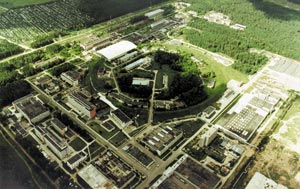
On 15 November 1963 the Institute for High Energy Physics (IHEP) received separate institute status, with Anatoli Logunov appointed its director a month earlier. The creation of an efficient team of scientists and specialists from Dubna, Moscow and Kharkov became a decisive factor in pushing forward the construction of the machine, the experimental area and the infrastructure of the new centre.
The research programme was determined by the Scientific Coordinating Committee that was created at IHEP in 1964. It was composed of leading scientists from IHEP and other institutes in the USSR: the Institute for Theoretical and Experimental Physics (ITEP), the Joint Institute for Nuclear Research (JINR), the Institute for Nuclear Research (INR), the Lebedev Physical Institute (LPI), Moscow State University (MSU), Moscow Engineering Physics Institute (MEPhI), the Kurchatov Institute (KIAE) and the Budker Institute for Nuclear Physics (BINP). The timely formation of the first priority research programme and the construction of the experimental facilities allowed experiments to begin at U-70 immediately after the machine’s commissioning, and new results in particle physics were soon obtained.
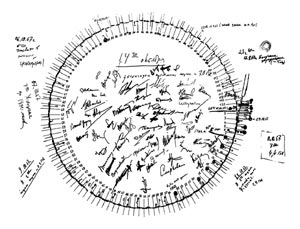
Another mission to be accomplished was the establishment of wide-ranging international collaboration. The construction of the biggest proton accelerator in the world opened up new possibilities in studying the microcosm, and many foreign physicists expressed an interest in taking part in the future research programme. However, it was not a simple task to organize international collaboration under the conditions of the time. Physicists from IHEP held talks with scientists from CERN and Saclay in France, and CERN director-generals Victor Weisskopf and Bernard Gregory played a significant role in helping to establish IHEP’s international collaboration with CERN.
IHEP signed the following agreements as early as 1966/7:
• The agreement concerning scientific and technical co-operation between CERN and the State Committee of the USSR on the Utilization of Atomic Energy (4 July 1967).
• The agreement between the State Committee of the USSR on the Utilization of Atomic Energy and the Commissariat on Atomic Energy of France concerning joint scientific research in high-energy physics at the 70 GeV accelerator (11 October 1966).
• The agreement concerning scientific collaboration between IHEP, Serpukhov and JINR, Dubna (16 April 1966).
The agreement with CERN assumed the fulfilment of a joint programme, which included the design and construction of a fast extraction system and RF separator, as well as the preparation and execution of joint experiments. The CERN-USSR Joint Scientific Committee was formed to coordinate and review this programme.
Commissioning and first experiments
The injector – a 100 MeV linac (L-100) – was put into operation in July 1967, and tuning the proton beam in U-70 began on 29 August. A circulating beam was achieved on 17 September and on 12 October a proton beam was accelerated up to the critical energy (8 GeV). The CERN delegation at IHEP, headed by Bernard Gregory, congratulated IHEP on this success, but expressed the opinion that more work and more time would be needed to pass the critical energy and reach the design energy of 70 GeV. However, on the night of 14 October, a record proton energy of 76 GeV was achieved in U-70.
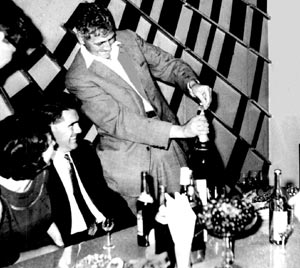
One of the first experiments on the U-70 accelerator, which was carried out by a joint IHEP-CERN team of physicists, was the measurement of the yield of secondary particles produced by 70 GeV protons on internal targets. This work involved high-resolution gas-differential Cerenkov counters with very low background (~10-6), and it allowed the study of pion, kaon and anti-proton yields up to momenta of 65 GeV/c. As a result, the new phenomenon of scale invariance was discovered in hadronic interactions at IHEP.
Immediately after the measurements of secondary particle yields, the IHEP-CERN team began to study the energy dependence of total cross-sections in hadron interactions. The results of studies of total cross-sections in the energy range below 30 GeV confirmed the well known data obtained at the Brookhaven National Laboratory in the US and at CERN. However, at energies higher than 30 GeV, while the total cross-sections for π+/–, K– mesons and protons remained constant, cross-sections for K+ mesons began to rise. The rise of the total cross-sections for K+p interactions in the range 15-55 GeV/c was equal to a few per cent. A number of international conferences in high-energy physics focused on this new phenomenon and the discovery became known as the “Serpukhov effect”. The measurements of total cross-sections at higher energies at CERN and at Fermilab confirmed the results that the IHEP-CERN team had obtained at U-70, and the rise in total cross-section was found to be a universal phenomenon for all hadrons.
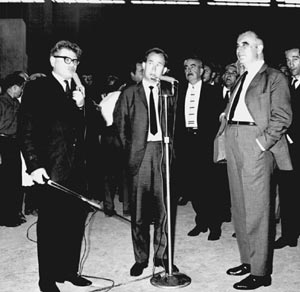
The agreement with France assumed the production and delivery to IHEP of a large hydrogen bubble chamber for experiments with separated hadron beams. Installed at the 70 GeV accelerator in 1970/1, the chamber, which was called Mirabelle, took more than three million pictures and produced a number of excellent physics results.
Continuing collaboration
The joint research programme at U-70 with physicists from JINR, CERN, the US and Japan has continued to the present day. The most well known physics results concern high spin mesons, glueballs and hybrids, while in detector and accelerator techniques important work has been done on polarization effects at high energies, GAMS-type spectrometers, liquid-argon spectrometers, lead-tungstate crystals for electromagnetic calorimetry and beam extraction by bent crystals. Of particular note are the invention of RFQ focusing and the construction of the first RFQ linac, URAL-30, at IHEP.
After the commissioning of the larger accelerators at Fermilab and at CERN, the physicists at IHEP began to take an active part in the experiments at higher energies. These included the neutrino experiments with the 15 ft bubble chamber; polarization experiments and experiments with D0 at Fermilab; experiments with GAMS-4000, EHS and BEBC at CERN’s Super Proton Synchrotron; and experiments with DELPHI at LEP and with PHENIX at RHIC, Brookhaven.
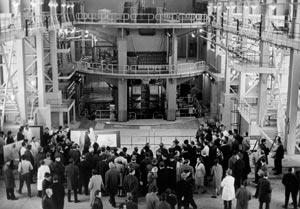
Nowadays, physicists from IHEP, together with those from JINR, CERN, INR, ITEP, MSU, MEPhI, LPI, KEK and the University of Michigan, are continuing their research programmes at U-70 in the fields of meson spectroscopy, K-meson rare decays, polarization effects and neutrino interactions. A unique channel of separated K-mesons is under construction at IHEP, the basic elements of which are two superconducting deflectors received from CERN. Among the latest results that have been obtained at U-70 are high-precision measurements of charged kaon decays, spin asymmetries in inclusive reactions and new data on the search for exotic mesons.
Collaboration between IHEP and CERN remains strong to this day, with physicists from IHEP participating in the ALICE, ATLAS, CMS and LHC-B experiments at the Large Hadron Collider (LHC), as well as in the design and production of equipment for the LHC. The most notable contributions made by the physicists from IHEP are septum magnets for beam injection and extraction systems, DC circuit breakers, dump resistors and components for the CMS forward hadron calorimeter and the ATLAS muon system.








